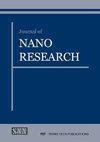基于微结构表面能模型的2D-FG纳米梁在不同边界条件下弯曲和稳定性响应的综合研究
IF 1
4区 材料科学
Q4 MATERIALS SCIENCE, MULTIDISCIPLINARY
引用次数: 0
摘要
研究了不同边界条件下双向功能梯度材料(2d - fgm)纳米梁的弯曲和静态稳定性特性。基于修正的耦合应力理论和表面弹性理论,建立了二维fg欧拉-伯努利梁的尺寸依赖模型。梁的材料特性沿轴向和厚度方向均按幂律分布平滑变化。结合单个材料长度尺度参数的连续空间变化和三个表面常数分别描述了微观结构和表面能的影响。该模型考虑了轴向和横向位移、物理中性面的确切位置和泊松效应。为了得到模型的静响应,采用里兹法,用多项式形式逼近轴向和横向位移。通过在位移函数中加入辅助函数,考虑并满足简单-简单(S-S)、夹紧-夹紧(C-C)、简单-夹紧(C-S)和无夹紧(C-F)等不同的边界条件。在不同边界条件下进行了数值计算,探讨了厚度和长度方向梯度指数、表面能、材料长度尺度参数、长细比和厚度对2D-FG纳米梁静态挠曲和屈曲响应的影响。结果表明,材料性能、表面能和微观结构效应对2D-FG纳米梁的弯曲和屈曲响应有显著影响。因此,本研究对二维fg纳米梁的弯曲和屈曲响应设计和优化具有一定的指导意义。本文章由计算机程序翻译,如有差异,请以英文原文为准。
A Comprehensive Study of Bending and Stability Responses of 2D-FG Nanobeams Using a Microstructure-Surface Energy-Based Model under Various Boundary Conditions
The size-dependent bending and static stability characteristics of nanobeams made of bi-directional functionally graded materials (2D-FGMs) under different boundary conditions are comprehensively investigated. Based on the modified couple stress theory and surface elasticity theory, the size-dependent model is formulated for 2D-FG Euler-Bernoulli beam. The material properties of the beam smoothly change along both the axial and thickness directions according to power-law distribution. The continuous spatial variations of the single material length scale parameter and the three surface constants are incorporated to describe the effects of microstructure and surface energy, respectively. This model accounts for the axial and transverse displacements, the exact position of the physical neutral plane, and Poisson’s effect. To obtain the static response of the present model, Ritz method is employed by approximating the axial and transverse displacements in terms of polynomial forms. Different boundary conditions, i.e., Simply-simply (S-S), Clamped-clamped (C-C), Clamped-simply (C-S), and Clamped-free (C-F), are considered and satisfied by adding auxiliary functions to the displacement functions. Numerical results with various cases of boundary conditions are performed with an insight to explore the effects of gradient indices in thickness and length directions, surface energy, material length scale parameter, slenderness ratio, and thickness on the static deflection and buckling responses of 2D-FG nanobeams. Results disclose that, the material properties, the surface energy, and microstructure effects have a significant effect on the bending, and buckling responses of 2D-FG nanobeams. Hence, this study can be helpful in the design and optimization of 2D-FG nanobeams in bending and buckling responses.
求助全文
通过发布文献求助,成功后即可免费获取论文全文。
去求助
来源期刊

Journal of Nano Research
工程技术-材料科学:综合
CiteScore
2.40
自引率
5.90%
发文量
55
审稿时长
4 months
期刊介绍:
"Journal of Nano Research" (JNanoR) is a multidisciplinary journal, which publishes high quality scientific and engineering papers on all aspects of research in the area of nanoscience and nanotechnologies and wide practical application of achieved results.
"Journal of Nano Research" is one of the largest periodicals in the field of nanoscience and nanotechnologies. All papers are peer-reviewed and edited.
Authors retain the right to publish an extended and significantly updated version in another periodical.
 求助内容:
求助内容: 应助结果提醒方式:
应助结果提醒方式:


